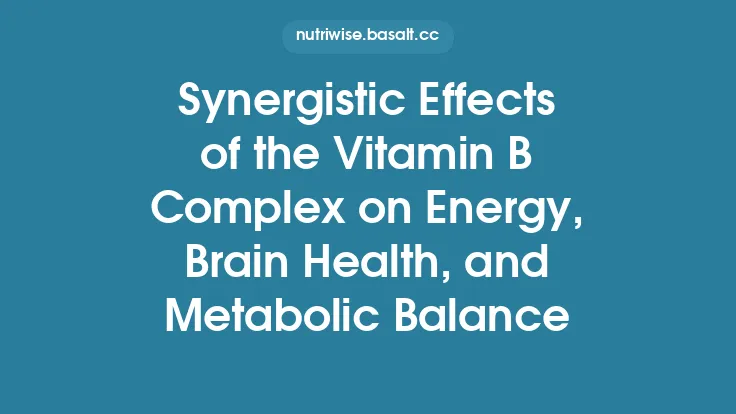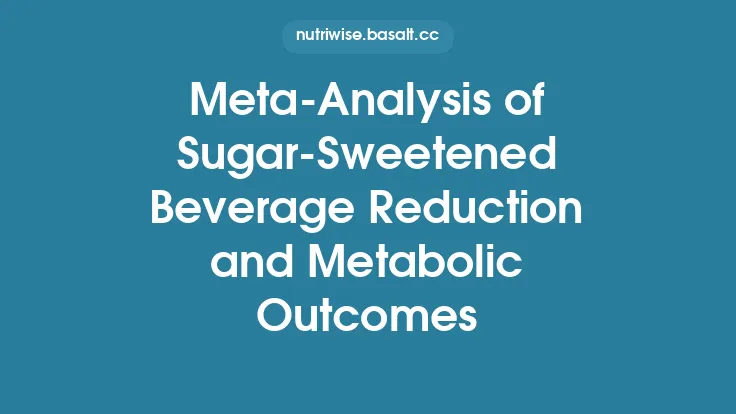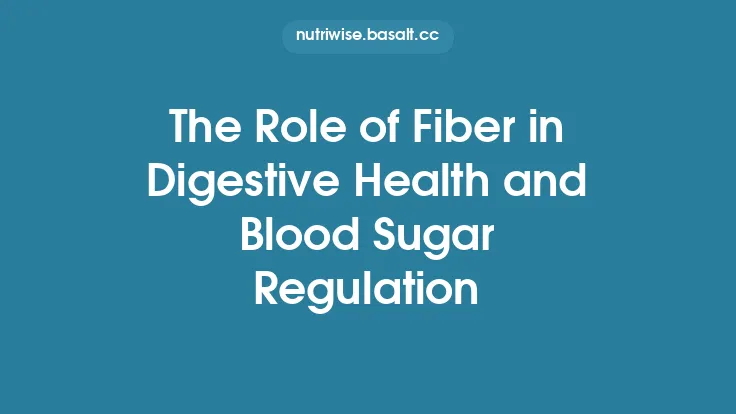Sugar consumption has been a focal point of nutrition research for decades, driven by its ubiquitous presence in modern diets and its strong links to metabolic disturbances. Over the past half‑century, the quantity, quality, and context of sugar intake have shifted dramatically, reflecting changes in food manufacturing, consumer preferences, and public‑health policies. This article synthesizes the most robust epidemiologic evidence on long‑term trends in sugar consumption and examines how these trends intersect with metabolic health outcomes such as type 2 diabetes, insulin resistance, non‑alcoholic fatty liver disease (NAFLD), and the broader metabolic syndrome. By tracing historical patterns, evaluating methodological advances, and highlighting persistent gaps, the discussion aims to provide a comprehensive, evergreen reference for researchers, clinicians, and policy makers interested in the sugar‑metabolism nexus.
Historical Trajectory of Sugar Intake: Global and Regional Patterns
Early 20th‑Century Baselines
National food balance sheets from the Food and Agriculture Organization (FAO) indicate that per‑capita sugar availability in the 1950s hovered around 10–12 kg yr⁻¹ in high‑income nations and under 5 kg yr⁻¹ in most low‑ and middle‑income countries (LMICs). These figures largely reflected consumption of sucrose derived from sugarcane and beet, with limited contribution from high‑fructose corn syrup (HFCS).
The Post‑World‑War Expansion (1960s–1980s)
Industrialization of food processing and the advent of HFCS in the United States catalyzed a rapid rise in added sugar availability. By the early 1980s, U.S. per‑capita intake of added sugars had climbed to ≈25 kg yr⁻¹, a 100 % increase from the 1950s. Parallel trends were observed in Western Europe, where refined sugar consumption rose modestly (≈30 % increase) due to greater availability of sweetened beverages and confectionery.
The Globalization Era (1990s–2000s)
The diffusion of multinational food corporations into emerging markets accelerated sugar intake in Asia, Latin America, and Africa. In China, per‑capita added sugar consumption surged from ≈3 kg yr⁻¹ in 1990 to >10 kg yr⁻¹ by 2010, driven by soft drinks, flavored yogurts, and processed snacks. Brazil and Mexico experienced similar jumps, with added sugar contributions to total energy intake reaching 12–15 % of daily calories in many urban cohorts.
Recent Plateau and Decline in High‑Income Countries (2010s–Present)
Public‑health campaigns, sugar‑tax policies, and reformulation initiatives have begun to blunt the upward trajectory in many high‑income nations. Data from the United Kingdom’s National Diet and Nutrition Survey (NDNS) show a modest decline in added sugar intake from 13 % of total energy in 2014 to 10 % in 2022. The United States’ NHANES cycles reveal a plateau around 13 % of energy, with slight reductions among adolescents after the implementation of the 2015–2020 Dietary Guidelines.
Socio‑Demographic Disparities
Across all regions, higher sugar consumption persists among younger adults (18–35 y), males, and individuals of lower socioeconomic status. In LMICs, urban residents consume 1.5–2 × the amount of added sugars compared with rural counterparts, reflecting differential access to processed foods and sugary beverages.
Sources of Sugar: Shifts in the Food Supply
Traditional Sucrose vs. High‑Fructose Corn Syrup
The proportion of HFCS in total added sugars peaked at ≈45 % of U.S. sweeteners in the early 2000s, then receded to ≈30 % by 2020 as manufacturers reverted to sucrose or blended sweeteners. In contrast, many Asian markets have seen a rapid rise in glucose‑fructose syrups derived from locally produced corn or tapioca starch.
Beverages as Dominant Contributors
Sugar‑sweetened beverages (SSBs) remain the single largest source of added sugars in most age groups. In Mexico, SSBs accounted for ≈40 % of added sugar intake in 2018, whereas in the United Kingdom the figure was ≈30 % in 2021. Notably, the share of sugars from fruit juices has risen in several high‑income countries, complicating surveillance because juices are often classified as “natural” despite high free‑sugar content.
Confectionery, Bakery, and Dairy
The relative contribution of confectionery (candies, chocolate) has declined in high‑income settings due to reformulation, whereas bakery products (cakes, pastries) have maintained a steady share. In LMICs, sweetened dairy products (flavored milks, yogurts) have emerged as a fast‑growing source, especially among children.
Epidemiologic Evidence Linking Sugar Trends to Metabolic Health
Type 2 Diabetes Incidence and Sugar Intake
Prospective cohort studies consistently demonstrate a dose‑response relationship between added sugar consumption and incident type 2 diabetes, independent of total caloric intake. A pooled analysis of 12 cohorts (≈500,000 participants) reported a relative risk (RR) of 1.21 (95 % CI 1.12–1.31) for each 5 % increase in energy from added sugars. Importantly, the association persisted after adjusting for body mass index (BMI), suggesting mechanisms beyond weight gain.
Insulin Resistance and Glycemic Load
Cross‑sectional data from the European Prospective Investigation into Cancer and Nutrition (EPIC) revealed that individuals in the highest quintile of added sugar intake exhibited a 0.4‑unit higher HOMA‑IR (Homeostatic Model Assessment of Insulin Resistance) compared with the lowest quintile, after controlling for physical activity and dietary fiber. Longitudinal analyses indicate that reductions in added sugar intake over a 5‑year period are associated with modest improvements in insulin sensitivity.
Non‑Alcoholic Fatty Liver Disease (NAFLD)
High fructose consumption, particularly from HFCS‑rich beverages, has been implicated in hepatic de novo lipogenesis. Meta‑analysis of 9 controlled feeding trials (n ≈ 600) showed that replacing 25 % of daily calories with fructose‑containing beverages increased liver fat fraction by 30 % relative to isocaloric glucose controls. Population‑based ultrasound studies in the United States and China corroborate these findings, linking higher SSB intake to greater NAFLD prevalence.
Metabolic Syndrome Components
Large-scale surveys (e.g., NHANES, Korean National Health and Nutrition Examination Survey) demonstrate that individuals consuming >10 % of energy from added sugars have higher odds of meeting the metabolic syndrome criteria (OR ≈ 1.5). The strongest associations are observed for elevated triglycerides and reduced HDL‑cholesterol, reflecting the lipogenic impact of excess simple sugars.
Methodological Advances in Sugar Surveillance
Food Frequency Questionnaires (FFQs) vs. 24‑Hour Recalls
Traditional FFQs tend to underestimate added sugar intake due to limited item granularity. The adoption of multiple 24‑hour dietary recalls, coupled with the Automated Self‑Administered 24‑Hour (ASA24) system, has improved precision, especially for beverages and discretionary sweets.
Biomarkers of Sugar Intake
Stable‑isotope analysis of carbon‑13 (^13C) in blood and hair provides an objective proxy for added sugar consumption, particularly HFCS. Recent validation studies report correlations of r ≈ 0.45 between ^13C enrichment and self‑reported added sugar intake, offering a valuable tool for correcting measurement error in epidemiologic models.
Integration of Sales and Trade Data
Linking national food balance sheets with retail scanner data enables more granular estimation of sugar availability at the sub‑national level. This hybrid approach has uncovered hidden regional disparities, such as higher per‑capita HFCS sales in the Southern United States compared with the Northeast.
Public‑Health Interventions and Their Impact on Trends
Fiscal Policies (Sugar Taxes)
Excise taxes on SSBs have been implemented in over 30 jurisdictions. In the United Kingdom, the Soft Drinks Industry Levy (SDIL) introduced in 2018 led to a 10 % reduction in sugar content of taxed beverages within two years, and a corresponding 8 % decline in population‑level SSB sales. Modeling studies estimate that the SDIL could avert ≈1,300 cases of type 2 diabetes per year in the adult population.
Reformulation Initiatives
Voluntary and mandatory reformulation targets (e.g., the U.S. FDA’s “Nutrition Facts” label changes) have prompted manufacturers to lower added sugar levels in breakfast cereals, yogurts, and flavored milks. Post‑reformulation audits show average reductions of 15–20 % in added sugar per product category.
Educational Campaigns
School‑based nutrition education programs that emphasize “sugar‑smart” choices have demonstrated modest but sustained reductions in SSB consumption among adolescents (≈0.5 servings/day decrease over 3 years). However, the effect size is generally smaller than that of fiscal measures.
Persistent Gaps and Future Research Directions
- Longitudinal Biomarker Validation – While ^13C isotopic signatures are promising, large‑scale longitudinal validation against clinical outcomes remains limited. Establishing standardized cut‑points for high versus low added sugar exposure would enhance comparability across studies.
- Differentiating Sugar Types – Most epidemiologic datasets aggregate all added sugars, obscuring potential differential effects of sucrose versus fructose‑rich sweeteners. Future cohort analyses should incorporate detailed ingredient‑level data to disentangle these effects.
- Life‑Course Exposure – Early‑life sugar exposure (infancy through adolescence) may program metabolic pathways. Prospective birth‑cohort studies with repeated dietary assessments are needed to clarify critical windows of susceptibility.
- Interaction with Genetic and Microbiome Factors – Gene‑diet interaction studies suggest that variants in carbohydrate‑metabolizing enzymes (e.g., KHK, SLC2A2) modulate the metabolic response to high sugar intake. Parallel investigations of gut microbiota composition could reveal mechanistic pathways linking sugar to insulin resistance.
- Equity‑Focused Analyses – Disparities in sugar consumption and metabolic outcomes are amplified by socioeconomic and geographic factors. Integrating social‑determinant variables into trend analyses will inform targeted interventions.
Concluding Synthesis
Over the past five decades, global sugar consumption has transitioned from a modest, predominantly sucrose‑based intake to a complex, multi‑source exposure dominated by sweetened beverages, processed foods, and increasingly, high‑fructose sweeteners. While high‑income countries have begun to curb this trajectory through policy, reformulation, and public awareness, many LMICs are still on an upward slope, mirroring the historical patterns of the West.
Epidemiologic evidence unequivocally links higher added sugar intake to adverse metabolic outcomes, including type 2 diabetes, insulin resistance, NAFLD, and the broader metabolic syndrome. These associations persist after accounting for total energy intake and adiposity, underscoring the metabolic toxicity of excess simple sugars.
Methodological refinements—particularly the incorporation of objective biomarkers and high‑resolution consumption data—are sharpening our understanding of these trends. Nonetheless, critical knowledge gaps remain, especially regarding the differential health impacts of specific sugar types, life‑course exposure effects, and the interplay with genetic and microbiome factors.
Continued surveillance, coupled with evidence‑based interventions such as fiscal policies, product reformulation, and targeted education, will be essential to reverse the upward tide of sugar‑related metabolic disease. By maintaining a rigorous, data‑driven approach, the nutrition epidemiology community can guide public‑health strategies that protect metabolic health across diverse populations for generations to come.





